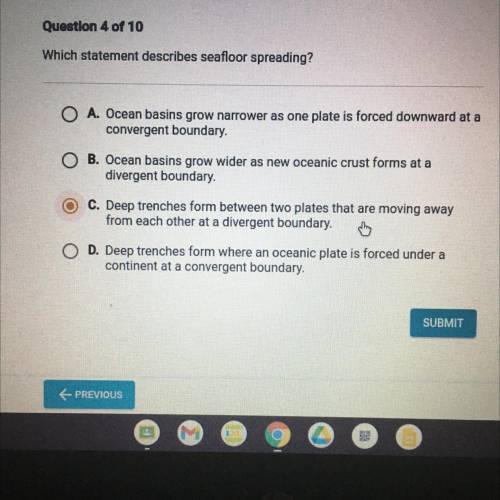Question 4 of 10
Which statement describes seafloor spreading?
A. Ocean basins grow narrower...

Chemistry, 09.12.2021 16:00 galarzachristopher
Question 4 of 10
Which statement describes seafloor spreading?
A. Ocean basins grow narrower as one plate is forced downward at a
convergent boundary.
B. Ocean basins grow wider as new oceanic crust forms at a
divergent boundary.
C. Deep trenches form between two plates that are moving away
from each other at a divergent boundary.
D. Deep trenches form where an oceanic plate is forced under a
continent at a convergent boundary.
SUBMIT


Answers: 1


Other questions on the subject: Chemistry

Chemistry, 22.06.2019 09:00, kcarstensen59070
What type of energy do chemical bonds have? what type of energy is it converted to during chemical reactions? question 15 options: chemical bonds have kinetic energy, which is converted to potential energy during chemical reactions. chemical bonds have electric energy, which is converted to potential energy during chemical reactions. chemical bonds have heat energy, which is converted to kinetic energy during chemical reactions. chemical bonds have potential energy, which is converted to heat energy during chemical reactions.
Answers: 1



Chemistry, 22.06.2019 14:30, jessiereyes2924
What is the relationship between wind and ocean waves? question 17 options: wind moving at higher speeds will transfer more energy to the water, resulting in stronger waves. wind moving at higher speeds will transfer energy over a larger part of the ocean water, resulting in waves with a shorter wavelength. winds moving at higher speeds with cause water to move forward at faster rates, causing larger ocean waves. winds moving at higher speeds will affect deeper water, resulting in waves that move at a faster rate. how do temperature and salinity affect deepwater currents? question 15 options: as temperatures and salinity levels of water increase, the water rises to the surface where it creates currents as it moves to colder regions. they create changes in wind direction, moving denser water in the same direction as the wind and causing the deepwater circulation patterns found in the ocean. they equalize the forces on undersea currents caused by the coriolis effect as they replace more dense water with less dense water. they create density differences that cause dense deepwater currents to flow toward the equator where they displace less dense, warmer water above them.
Answers: 2
You know the right answer?
Questions in other subjects:


Arts, 20.10.2021 09:10




Medicine, 20.10.2021 09:10



Chemistry, 20.10.2021 09:10



